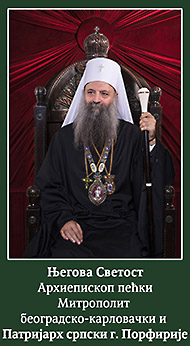St. Basil the Great, Archbishop of Cæsarea in Cappadocia
![]() Saint Basil the Great, Archbishop of Caesarea in Cappadocia, “belongs not to the Church of Caesarea alone, nor merely to his own time, nor was he of benefit only to his own kinsmen, but rather to all lands and cities worldwide, and to all people he brought and still brings benefit, and for Christians he always was and will be a most salvific teacher.” Thus spoke Saint Basil’s contemporary, Saint Amphilochius, Bishop of Iconium.
Saint Basil the Great, Archbishop of Caesarea in Cappadocia, “belongs not to the Church of Caesarea alone, nor merely to his own time, nor was he of benefit only to his own kinsmen, but rather to all lands and cities worldwide, and to all people he brought and still brings benefit, and for Christians he always was and will be a most salvific teacher.” Thus spoke Saint Basil’s contemporary, Saint Amphilochius, Bishop of Iconium.
Saint Basil was born in the year 330 at Caesarea, the administrative center of Cappadocia. He was of illustrious lineage, famed for its eminence and wealth, and zealous for the Christian Faith. The saint’s grandfather and grandmother on his father’s side had to hide in the forests of Pontus for seven years during the persecution under Diocletian.
Synaxis of the Most Holy Mother of God
The Synaxis of the Most Holy Theotokos: On the second day of the feast, the Synaxis of the Most Holy Theotokos is celebrated. Combining the hymns of the Nativity with those celebrating the Mother of God, the Church points to Mary as the one through whom the Incarnation was made possible. His humanity—concretely and historically—is the humanity He received from Mary. His body is, first of all, her body. His life is her life. This feast, the assembly in honor of the Theotokos, is probably the most ancient feast of Mary in the Christian tradition, the very beginning of her veneration by the Church.
The Monk Naum of Ohrid
Commemorated on December 23, Jan 5 and June 20
The Monk Naum of Ohrid, was one of the disciple of the holy Equal-to-the-Apostles Cyril and Methodios (Comm. 11 May), and he likewise accompanied Saint Kliment (Clement) of Ohrid during the time of his preaching of the Gospel in the Balkans. When Saint Kliment set off to the south-western regions, the Monk Naum remained in the then capital city of Plisk. Afterwards the Monk Naum became successor to Saint Kliment in a monastery on the shores of Lake Ohrid, where he asceticised for 10 years. The Monk Naum reposed on 23 December 910, and his relics were glorified by numerous miracles, especially healings of sicknesses of soul.
An Online Orthodox Catechism adopted from ‘The Mystery of Faith’ by Bishop Hilarion Alfeyev
HOW TO EXPLAIN THE MYSTERY OF THE HOLY TRINITY?
One of the simplest ways of explaining the mystery of the Trinity is that reportedly given by St Spyridon of Trimithund at the Council of Nicaea (AD 325). According to tradition, when asked how it is that Three can simultaneously be One, St Spyridon responded by taking up a brick and squeezing it. From the soft clay in his hands a flame showed up while simultaneously water flowed downwards. ‘As there is fire and water in this brick’, said St Spyridon, ‘in the same way there are three Persons in the one Godhead’.
St. Gabriel, Serbian Patriatrch
Gavrilo I Rajić (died 1659) was Archbishop of Peć and Serbian Patriarch between 1648 and 1655. He was murdered by Turks and therefore celebrated by Eastern Orthodox Church as Hieromartyr. His feast day is celebrated on December 13.






